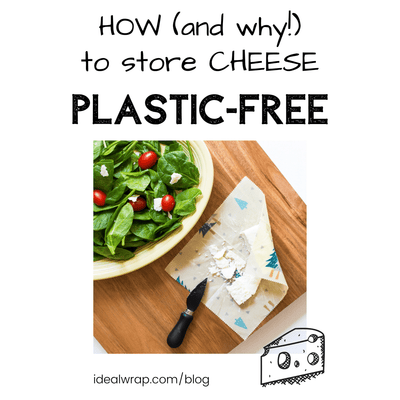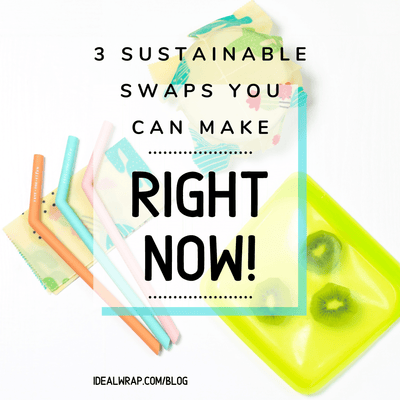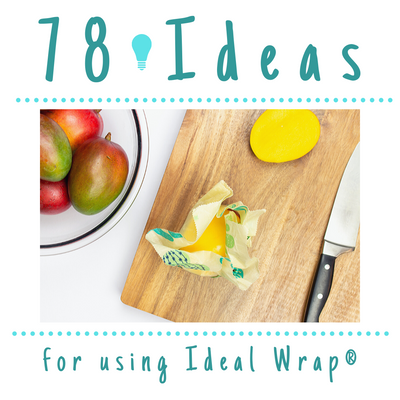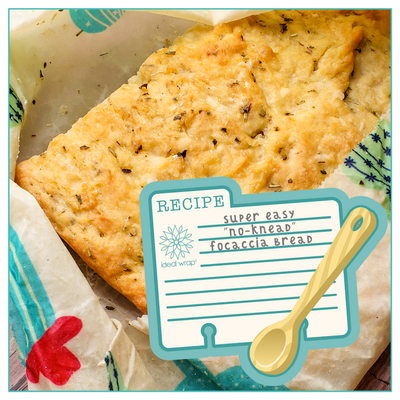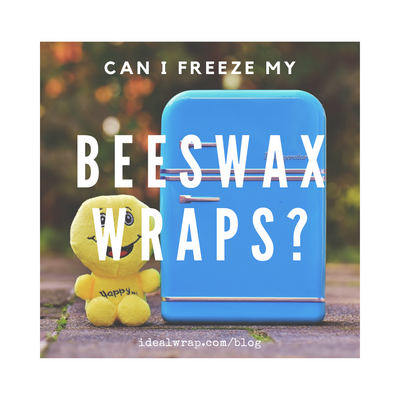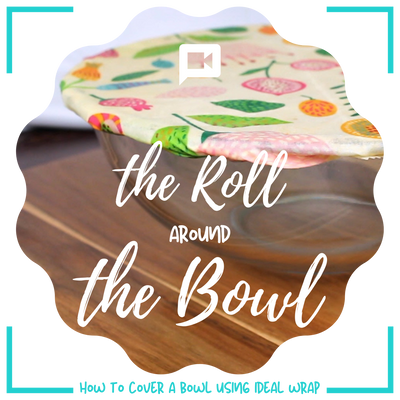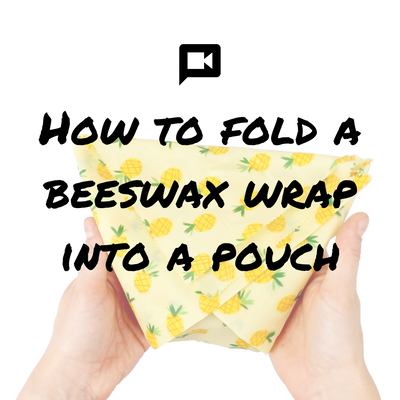Ideal Wrap 101: What is a Beeswax Food Wrap
Perhaps you’ve heard about them from a friend, seen them on Instagram, or maybe your kids even made some at school. In a world where less plastic is better, sustainable consumer goods are becoming more popular – which is a darn good thing!
Beeswax Wrap 101
A lot of plastic household waste comes from the kitchen. Nearly everything we buy to eat, drink, or use in the kitchen comes in packaging, and then there is the need to store food as various stages, whether that’s as soon as we get it home, after it’s washed, chopped, and prepped, or when it becomes leftovers.
But with a little planning and creativity, we can reduce the packaging we bring home from the store, as well as the disposable products we have so long used for wrapping foods up for later.
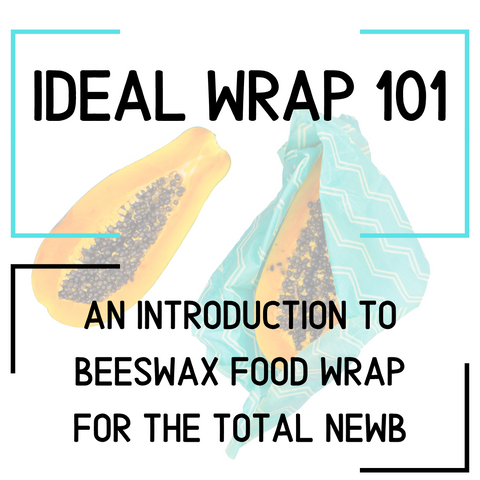
Beeswax food wrap is becoming the popular alternative to plastic wrap due to its reusability, inherent ‘stickiness,’ and ability to keep foods like cheese, fruits, and veggies fresh in the refrigerator.
While not a “cheap” product, quality beeswax food wrap is a great investment, and certainly pays for itself not only in replacing disposable plastic cling wrap, baggies, and even containers, but also by reducing food waste, keeping foods like vegetables and cheese from going bad in air tight containers from their own emitted gasses.
What is a beeswax food wrap?
A beeswax food wrap is cotton fabric that has been coated in a blend of beeswax, plant oil (usually jojoba), and some type of tree resin (usually pine resin).
The result is a food covering that is breathable, pliable, self-adhesive, and naturally antimicrobial, as well as 100% organic, washable and reusable, and finally, biodegradable and compostable.
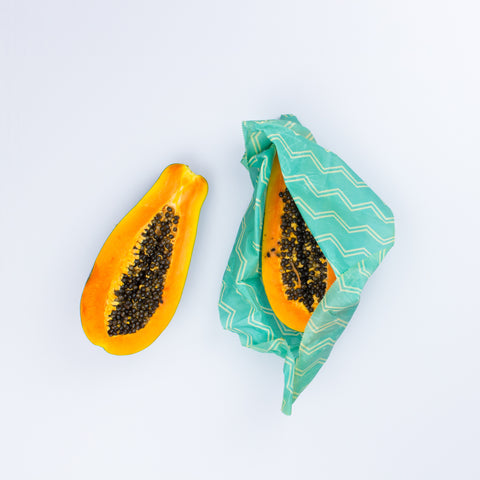
What does it do?
Beeswax wrap is primarily used for storing and transporting food, in place of disposable plastic products. Keeping the other half of fruits and veggies fresh in the refrigerator is what beeswax wrap does best, but it is also excellent for storing cheese, wrapping sandwiches, and covering dishes and containers!
While some foods do need to be stored air tight (artichokes and okra are good examples, since they must be kept very dry), most fruits and vegetables, and especially cheeses, benefit from the breathability of the wrap.
What are the advantages to using beeswax food wrap?
There are many advantages to using beeswax food wrap!
Ideal Wrap is an excellent food preserver, so you’ll get more life (a few days!) out of the other half of that avocado. As previously mentioned, beeswax wrap is not airtight, so the gases naturally emitted from foods are allowed to escape. Ethylene gas emitted from fruits and vegetables can quickly over-ripen, and finally rot, foods stored in an airtight plastic baggie. And the ammonia gas emitted from cheese in an airtight container can quickly be re-absorbed, causing cheese to go bad quickly. Read more about how to store cheese here.
But the environmental benefits are typically the most talked about. No plastic, no chemicals, and highly reusable – beeswax food wrap is making headlines as the sustainable alternative to conventional food storage.
Ideal Wrap has other benefits as well! It doesn’t take up very much space, it’s really easy to use, and it’s ridiculously cute, with a variety of beautiful prints to brighten your kitchen and your mood. It also comes pre-cut into four different sizes to fit a variety of tasks. Oh, and always having an incredibly effective jar opener on hand is another one of my favorite advantages!

What about disadvantages?
While there aren’t any true disadvantages of using the wraps themselves, there are a couple of caveats that you should know about.
For one, there is a little care involved to using beeswax food wraps. They must be kept clean and dry to prevent mold and to get the most life out of them as possible. Fortunately, this is a rather simple ritual, but it’s not a product that can be tossed in the dishwasher.
Additionally, beeswax has a relatively low melting point (around 143° F) so heat will all but ruin your wrap. Therefore, it cannot be used on hot foods, microwaved, or left out in the sun.
If you're interested in more pros and cons of beeswax food wrap, check out this post.
How do you actually use it?
One of the great advantages to beeswax food wrap is that it’s so easy to use. You can wrap, fold or scrunch it directly around foods, or use to cover containers and dishes. I have also had great success with folding my wrap into a pouch for loose items like broccoli florets. You can even get a watertight seal on a jar or bowl – just spend a little extra time molding and shaping the wrap to the rim. To wrap a sandwich, simply fold all four corners to the top, and flip over to let the weight of the sandwich seal the wrap – no smushing necessary!
And for more ideas about how to use Ideal Wrap – head over to our 78 Ways to Use Ideal Wrap post!

How do you clean it?
Ideal Wrap is very easy to clean, with just a couple of caveats.
But first, if your wrap isn’t dirty – don’t wash it. Because the beeswax coating has natural antimicrobial properties, you don’t need to wash your wrap after every single use. To get the most out of your wrap, keep it clean without water when you can (i.e. brush off crumbs with your hands or spot clean with a dry/damp towel). While it’s perfectly safe to wash in cold water, the extra handling from washing and drying will eventually take a toll on your wrap.
When your wrap is slightly dirty from wrapping fruits, veggies and sandwiches, give your wrap a rinse under cold water. The colder the water, the better it is for your wrap. The cold water will harden the beeswax coating, keeping it in place. You can then rinse away those dried fruit juices without needing to scrub. Use your hand to mobilize anything that has already dried onto the wrap.
If your wrap is really dirty, that’s ok! Avocados are always leaving that green-turns-to-brown gunk on the surface of my Ideal Wrap. If you simply need to clean off bits of dried gunk, run the wrap under cold water and gently scrape it away with the back of a spoon. (Pro tip: for larger sized wraps, clean your sink first, so you don’t have to worry about the wrap touching the bottom of the sink.) Again, the cold water will harden the coating, and you will be able to remove everything else with ease. If your tap water isn’t all that cold (like at my house in central Florida!) you can pop your wrap in the freezer for 30 seconds to help harden the coating.
If your wrap needs some extra cleaning attention, grab a mild dish soap (Mrs. Meyer’s works well) and lather your wrap from top to bottom, again, using the coldest water you can. Rinse completely.
Once you’ve gotten your wrap clean, pat excess water with a low-lint dish towel and hang to dry.
If your wrap has a funky smell, that’s ok, too! Onions, aromatic cheeses, and that broccoli you forgot about in the back of the fridge(oops) can all leave a bit of a scent behind. This is far more common for an older wrap that has been handled and washed, when the beeswax coating has started to wear down. To remove odors, lather with cold water and dish soap as described above, and allow the wrap to air out for a few days (I drape mine over a decorative item in my kitchen that’s out of the way). I have wrapped TONS of half-cut onions in Ideal Wrap, and have always been able to air the smell out in 2 days or less.

How should I store it?
Ideal Wrap is easy to store, but there are a few rules I like to go by. For one, ensure your wraps are clean and dry before you put them away. If you store your wraps damp they can mold. Also, be careful storing them in a drawer next to your dishwasher, as the humidity of the dishwasher can potentially cause mold if stored this way long enough (ask me how I know). Once your wraps are clean and dry, fold them up and put them back in the original packaging for the very best preservation. Since the wrap is sticky, it can definitely attract dust. Keeping them inside the packaging prevents airborne particles like dust and dog hair from sticking to your wrap.
How do I recycle it?
Ideal Wrap is super easy to recycle, as well as 100% compostable and biodegradable, so once they do finally wear out, you can throw them in with your compost. However, there are some alternatives to throwing them out!
Recently, I did a night market for Ideal Wrap, for which I needed to light up my tent with string lights. I used scraps from an old wrap (it had taken on too much dirt from being used as a demo at outdoor markets to be used anymore) to create twist-ties, and hung up ALL my tent lights with only one small-sized wrap! I must say, strips of old wraps definitely come in handy for projects like this, especially when the alternative is single-use, plastic zip-ties!
Other reuse ideas include ultra-portable fire-starters for grilling and camping, as well as using old wraps to pack dog treats for a day trip, pick up fresh flowers, or even as non-slip shelf liners.
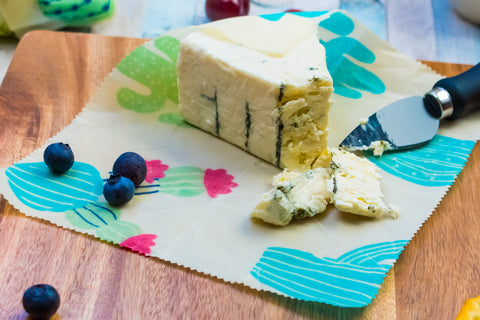
Can I make them last longer?
If your wraps feel dry, begin to crack, or just look kinda shabby, don’t repurpose or toss them just yet! You can quickly and easily double the life of your beeswax food wrap by giving it a little tender love and care when it starts to look like it needs it.
The basic idea is to warm the wrap just until the coating starts to melt. You can do this on a cookie sheet in the sun or with a hairdryer! For the full tutorial, check out this post!
What did I forget?
I’m sure that’s not all the questions you have about beeswax food wrap, but I hope I gave you a really great starting point!
If there are other questions you have, comment on this post and I will answer them!!
If you are looking for more information about our company and our wraps, you can check out our Everything You Need to Know About Ideal Wrap page.
And if you’re ready to shop, you can view all our collections here.
Peace, love, and avocados,
- Emily at Ideal Wrap

